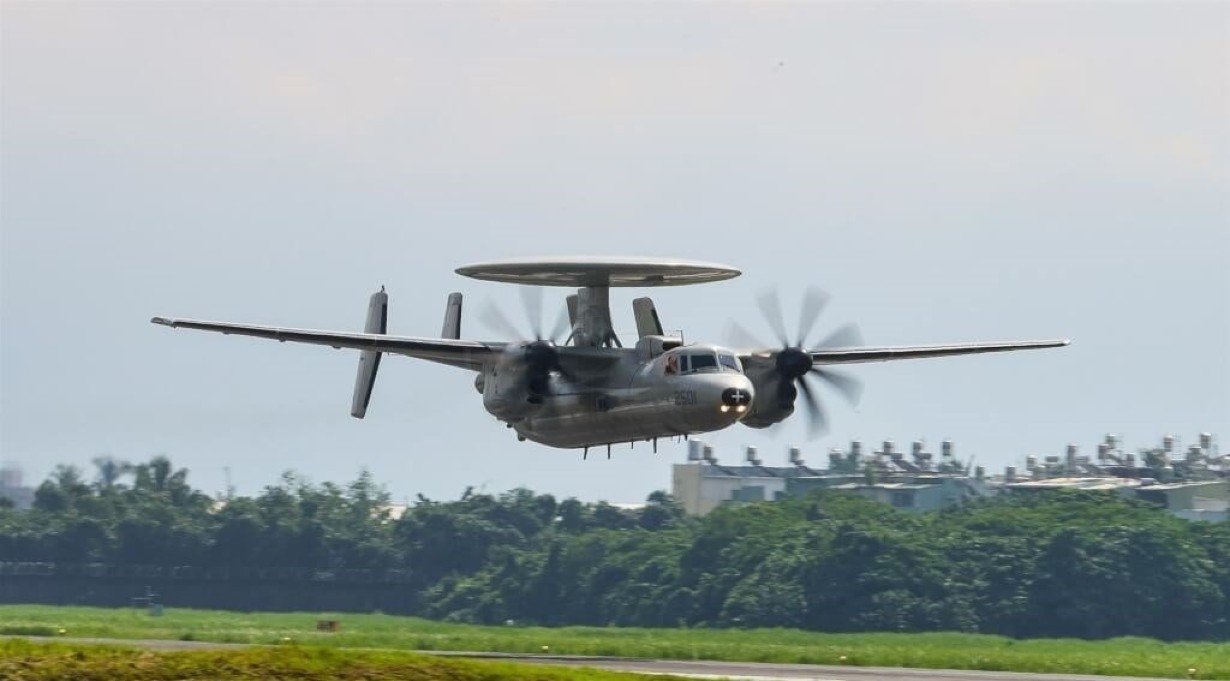On November 25, an E-2K airborne early warning (AEW) aircraft of Taiwan’s Air Force went off the runway while landing at an airbase in Pingtung County, the Air Force Command Headquarters said.
The Air Force said that the United States-manufactured plane assigned to the Pingtung airbase was returning from a training flight when the incident occurred around 11:08 a.m. The incident didn’t result in any casualties.
The pilot was apparently forced to perform a belly landing at the military airfield because the landing gear did not deploy. The military said a special task force had been established to investigate the malfunction’s root cause.
Pingtung Air Base is a former joint-use airfield fully taken over by the ROCAF in 2011. It is situated on Taiwan’s southwest coast. The 6th Tactical Mixed Wing is now housed there.
The 20th Electronic Warfare Group, which flies two E-2K aircraft—a Taiwanese variant of the Northrop Grumman E-2C Hawkeye Airborne Early Warning Aircraft—has been a part of the wing since 2000.
The Air Force is said to have six E-2K early warning aircraft. While the military has concealed the specific performance of the aircraft, each plane is known to be capable of tracking a target up to 500 kilometers away.
The E-2K is an all-weather early warning and control aircraft made by Northrop Grumman that has eight-blade propellers, modernized radar and surveillance systems, and cutting-edge software and avionics.

The island nation procured the E-2K AEW under the joint effort of the ROCAF, the USAF, and Grumman in 1995. The aircraft was put into service in September of the same year and is now considered a crucial military facility for the defense of the Taiwan Straits.
In 2021, the Air Force reportedly planned to buy six E-2D Advanced Hawkeyes (AHE) early warning aircraft 2021, but the cost has raised questions about the purchase.
The E-2D AHE is the latest variant of the E-2 aircraft platform. It is outfitted with an active electronic scanning array radar, allowing it to locate targets beyond the range of Taiwan’s fleet of E-2C Hawkeye 2000s.
Past Incidents
The new incident adds to a long list of aircraft accidents the Taiwanese Air Force has encountered. The Air Force has experienced three aircraft mishaps this year in addition to the latest one.
In January 2022, an upgraded F-16 fighter jet (Viper) crashed into the sea off western Taiwan thirty minutes after taking off from the southern Chiayi air base for routine training. Following that, Taiwan’s air force suspended all the combat training for its F-16 fleet.
On March 14, a Dassault Mirage 2000 fighter jet taking part in a training mission from Chihhang Air Base crashed into the ocean due to a mechanical issue. Since 1999, eight Mirage 2000 fighter jets are said to have crashed in Taiwan.
Seven pilots have been saved from these crashes, but five have lost their lives while carrying out their duties. Fifty-four Mirage 2000s are still in good condition, while six have been damaged beyond repair.
In May, an AIDC AT-3 training plane that had taken off from Kaohsiung, a southern port city, crashed during a training mission. At the time, the air force halted all academy training flights, and President Tsai Ing-wen ordered an investigation into why the incident occurred.
In November 2020, a single-seat F-16 operated by a 44-year-old pilot disappeared from radar two minutes after embarking from Hualien air base in eastern Taiwan, prompting Taiwan to ground all of its F-16 fighter jets for safety inspections.
Less than three weeks before that incident, a pilot perished when his F-5E fighter plane fell into the water during training, resulting in a similar grounding.
In 2021, two F-5E jets put into service in Taiwan in the 1970s crashed into the water off Taiwan’s southeast coast after colliding in midair during a training flight.
These occurrences significantly threaten the Taiwanese Air Force’s ability to repel Chinese warplanes. According to experts, the almost daily fly-bys of People’s Liberation Army jets, intended to increase pressure on the island, have reportedly worn out the military pilots.
The defense ministry says that every time the PLA has dispatched aircraft near Taiwan’s air defense identification zone, the island’s air force has to scramble jets to challenge Chinese PLAAF warplanes.
- Contact the author at ashishmichel(at)gmail.com
- Follow EurAsian Times on Google News